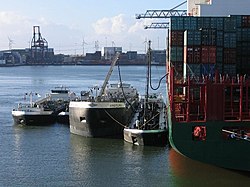IMO Net-Zero Framework
| MARPOL Annex VI chapter 5 | |
|---|---|
 176 IMO member states[1] | |
| Drafted | 11 April 2025 |
| Parties | Members of the IMO |

The IMO Net-Zero Framework is a United Nations system to price maritime shipping emissions. It is set to apply from 2028 to shipping in IMO member countries, applying a carbon price of 100 USD per tonne of CO2 equivalent.[2][3]
The Framework would be the first global pricing mechanism for emissions, to be administered by the United Nations's International Maritime Organization. It was drafted by Marine Environment Protection Committee Meeting 83 (MEPC83) and is scheduled for adoption by the IMO at an extraordinary meeting in October 2025.[2][3][4]
Maritime shipping represents 3% of global greenhouse gas emissions. The Framework would apply to ships above 5,000 gross tonnage, which account for 85% of those emissions.[1][5]
System
[edit]In the run-up to MEPC83, countries heavily debated what form the carbon pricing mechanism should take—a simple levy was favoured by around 60 island nations, while 16 mainly bigger emerging market economies favoured a carbon trading system in which clean ship operators could sell their rights to pollute to emissions-heavier ones.[6]
In the end, countries agreed on a carbon trading system with two tiers, based on a proposal by Singapore. If ship operators were to fail to meet hard emission reduction targets, they would be able to buy cheaper extra certificates. If they were to fail easy emission targets, however, they would have to buy expensive extra credits. This system is designed to preserve decarbonisation incentives.[6][2]
Targets
[edit]The IMO Net-Zero Framework sets various intermediate targets on the way to net-zero shipping emissions by or around 2050.[2][6]
Use of funds
[edit]Under the Framework, companies would pay for their emissions to a newly created IMO Net-Zero Fund. The money would be used to mitigate negative impacts of climate change on vulnerable countries, including small island developing states (SIDS) and least developed countries (LDCs).[5]
External links
[edit]- Draft text of MARPOL Annex VI chapter 5, outlining the Net-Zero Framework
See also
[edit]References
[edit]- ^ a b Mohamed, Ali (2025-03-24). "Climate finance needs shipping industry to launch first global tax". Climate Home News. Retrieved 2025-04-28.
- ^ a b c d "Landmark agreement towards achieving net-zero emissions from global shipping by 2050". European Commission - European Commission. Retrieved 2025-04-28.
- ^ a b "IMO approves net-zero regulations for global shipping". www.imo.org. Retrieved 2025-04-28.
- ^ "Setting the scene for ammonia maritime fuel: regulatory needs and timelines to decarbonize shipping". Ammonia Energy Association. 2025-03-21. Retrieved 2025-04-28.
- ^ a b "Countries reach historic deal to cut shipping emissions | UN News". news.un.org. 2025-04-11. Retrieved 2025-04-28.
- ^ a b c Gabbatiss, Josh (2025-04-11). "Q&A: Nations agree carbon-pricing system to steer shipping towards net-zero". Carbon Brief. Retrieved 2025-04-28.
